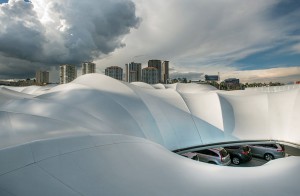Tensile Architecture Innovation: The History of Tensile Fabric Structures

One of the earliest tensile fabric innovations came from the Roman Empire where fabric canopies were adapted for large-scale use at the Colosseum using horizontal poles to support the outstretched fabric. After the fall of the Roman Empire, there were few technological advances due to low demand and lack of resources including, cables, canvasses and connections.
Modern Tensile Fabric Structures
As manufacturing processes greatly improved during the Industrial Revolution there was a new exciting surge in technologies for building materials, such as the mass production of steel.
In the late 19th century Russian engineer and architect Vladimir Shukhow produced pioneering work on new methods of analysis for structural engineering. That led to breakthroughs in industrial design for the world’s first hyperboloid structures, lattice shell structures, tensile structures and more.
Today, modern advances in technology, design and applications have continued to contribute to the large demand for tensile fabric structures. Other drivers to the growth of tensile fabric architecture are sustainability and energy efficiency. Tensile structures generally use light coloured roofs to reduce the heat. They also use very small amounts of material for large spans, provide translucency for natural daylighting and allow for natural ventilation using the Venturi effect.
Munich Olympic Stadium
One of the major advances to the field is attributed to the German architect and engineer, Frei Otto, who since the 1950s conducted the first scientific studies using tensioned steel cables and membranes to create roofing systems.
One of Otto’s most significant contribution to this industry was the Munich Olympic Stadium, in 1972. Otto, in collaboration with Behnisch and Partners, created a vast canopy for the Munich Olympic Stadium, today a celebrated landmark.
Symbolic as it was practical, this stadium stood in stark contrast to the 1936 Berlin Olympics, which was designed to proclaim the power of the Third Reich by the visual domination of its surroundings. The concept for the 1972 Munich stadium was derived from the ‘earth stadiums’ commonly built in Eastern Europe since the early 20th century. The stadium would be carved out of the ground, instead of built on top. This way the stadium would not present visitors with an imposing façade, but blend more subtly into the Bavarian landscape. In true symbolic design, it would stand equal within an environment of hills, streams and small lakes.
The tensile roofs of steel cable and acrylic panels stretched over the Olympic site like a massive, segmented tent. The translucency of the canopy was designed to shelter the athletes and spectators without obscuring lines of sight or casting uneven shadows that would affect televised footage.
The enormous structure covered almost 75,000 square meters and used 271 miles of steel cable strung between fifty-eight cat steel pylons, supporting a canopy composed of 8,000 Plexiglass panels. It was an impressive technical feat!
Source: JJCarter





